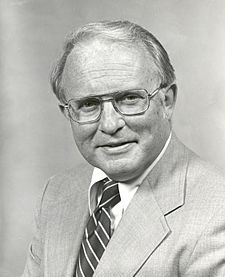Alan M. Lovelace facts for kids
Quick facts for kids
Alan M. Lovelace
|
|
|---|---|
 |
|
| Born | September 4, 1929 |
| Died | April 18, 2018 (aged 88) |
| Alma mater | University of Florida in Gainesville |
| Scientific career | |
| Fields | Organic Chemistry |
| Institutions | NASA |
| Thesis | The use of the peroxide-catalyzed reactions of bromofluoromethanes in the preparation of olefins and dienes containing fluorines (1954) |
| Doctoral advisor | Paul Tarrant |
Alan Mathieson Lovelace (September 4, 1929 – April 18, 2018) was a very important leader at NASA. He served as the Deputy Administrator of NASA from 1976 to 1981. This means he was one of the top people helping to guide NASA's space missions and research.
He even stepped in as the acting Administrator twice. First, he filled in when James C. Fletcher retired in 1977 during the Jimmy Carter administration. Later, he served again at the start of Ronald Reagan's presidency in 1981, until James M. Beggs was officially approved.
Contents
Early Life and Education
Alan Lovelace was born in St. Petersburg, Florida. He loved science and studied chemistry at the University of Florida in Gainesville.
He earned his first degree, a Bachelor of Science in Chemistry, in 1951. He continued his studies, getting a Master of Science degree in Organic Chemistry in 1952. Then, he earned his highest degree, a Doctor of Philosophy (Ph.D.), also in Organic Chemistry, in 1954.
Career in Government and Science
After finishing his studies, Lovelace served in the United States Air Force from 1954 to 1956. After that, he began working as a government scientist. He joined the Air Force Materials Laboratory (AFML) in Ohio.
At AFML, he first worked with fluorine and polymer chemistry. His work helped create new materials that could be used in very hot or cold conditions. These materials were important for things like aircraft and spacecraft.
Leading Air Force Research
In 1964, Alan Lovelace became the Chief Scientist of the Air Force Materials Laboratory. In this role, he helped develop strong, lightweight materials called composites. These materials are often used in modern aircraft and other advanced technologies.
By 1967, he was named the Director of the Air Force Materials Laboratory. Later, in 1972, he became the Director of Science and Technology for the Air Force Systems Command. Here, he guided the technical work and management for many Air Force laboratories.
Joining NASA
In 1973, Lovelace became a top advisor for the Assistant Secretary of the Air Force for Research and Development. He helped direct all of the Air Force's research programs.
Then, in 1974, he moved to NASA. He became the Associate Administrator of the NASA Office of Aeronautics and Space Technology. In this important job, he was in charge of research programs. These programs developed new science and technology for future airplanes and space exploration.
Awards and Later Career
Throughout his career, Alan Lovelace was recognized for his achievements. He became a Fellow in the American Astronautical Society. He also joined the National Academy of Engineering and other important scientific groups like Sigma Xi and Phi Beta Kappa.
In June 1981, President Ronald Reagan honored Lovelace with the Presidential Citizens Medal. This award recognizes American citizens who have performed exemplary deeds of service for their country or fellow citizens.
After leaving NASA, Lovelace worked for the General Dynamics Corporation. He became a Corporate Vice President, focusing on science and engineering. By 1985, he was leading the company's Space System Division. He helped develop the Atlas space launch vehicles, which are rockets used to send things into space.
He later became the Senior Vice President for Space Policy and Technology at General Dynamics. He also chaired the company's Commercial Launch Services.
Alan Lovelace passed away on April 18, 2018, in Melbourne, Florida.

